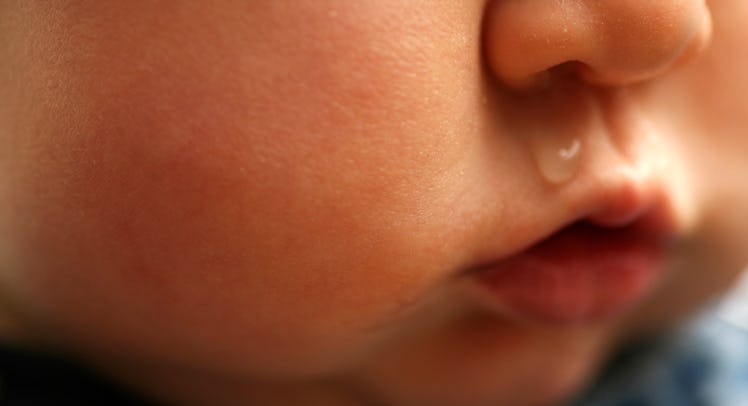How to Diagnose and Treat Baby Mucus Problems
Boogers are a common symptom of much of cold and flu season, but parents have options for keeping nasal passages clear and children comfortable.

So, that idea that parents can tell what kind of bug babies are suffering from by the color of their boogers? Total nonsense. Baby boogers aren’t mood ring and make lousey diagnostic tools. That said, an overflowing of mucus does indicate upper respiratory infection. Could be a cold. Could be the flu. Could be allergies. Whatever the cause, parents should neither panic about a runny nose or ignore one — especially if it belongs to an infant they believe might have been exposed to pathogens.
“For younger infants, we worry if this involves the lungs or does this need the ears checked,” says Chicago-based pediatrician Dr. Shelly Vaziri Flais, author of Raising Twins: Parenting Multiples From Pregnancy Through the School Years. “Any child of any age with a fever for more than 48 hours should be evaluated by the pediatrician. In a young infant – birth to 3 months – we consider a temperature of 100.4 to be a fever.”
How to Clear Boogers
- Time and Care – most times, respiratory infections are viral, and the only option is to let them run their course. Booger color may not be able to indicate a sinus infection, but time can. Infant colds usually last 10-14 days; if the cold is getting worse at the end of that time frame, it may actually be a sinus infection
- Use Suction Right Before Feeding – nasal congestion can discourage a child’s feeding, since it makes it hard for them to drink. Using a bulb syringe or nasal aspirator right before feeding can clear their nose and rouse them for a vigorous meal
- Don’t Over Do It – using suction too much can damage nasal passages, causing more problems. Parents should limit it to three or four times a day. Saline drops and sprays, as well as a wet, warm washcloth, can help keep baby noses clear in between feedings
- Watch for Other Symptoms – a temperature greater than 100.4 for longer than 48 hours in young infants is worth contacting a pediatrician, as well as distress breathing.
After three month, respiratory infections pose less of a threat to babies despite becoming depressingly common. Flais points out that kids can get on average six to eight respiratory infections a year, so it’s possible for kids to recover from one illness only to come down with something the next day. That means a lot of snot during the cold and flu season, which has its own complications.
“The biggest issues with boogers is that they block the baby’s small nose, and it makes it hard to drink,” warns Flais. “If it’s a choice between breathing and drinking, breathing always wins. So the more we can clear the congestion, the better.”
Most respiratory bugs are viral, not bacterial. So there’s no option to clear things up in a day with a dose of antibiotics. The course of action for most clogged noses is time and care. Over-the-counter saline drops or nasal puffers can help loosen crusty and dried mucus in the same way that a steamy shower can help an adult. Humidifiers can also help prevent air passageways from getting too dry in the first place. But the fastest way to clear out congestion is with suction. Most hospitals send a bulb syringe home with parents, and though it is a proven design, it can be hard to wash and hard to see exactly what comes out. Nasal aspirators that use oral suction are usually clear, so parents can see how productive each suck is, but on the other hand, the whole idea is kind of gross.
RELATED: Your Baby Has A Cold – Here’s What To Do Next
It’s easy to over-do suction; it works and it seems to cause instant relief. Using it more than three or four times a day, though, and parents can risk irritating small blood vessels in the nose, causing nose bleeds or even more mucus production.
“I usually tell families to use suction right before a feed – it clears everything out and riles the kid up a little bit so they are ready to drink,” advises Flais. In between feedings, parents can use saline solutions and a warm washcloth to clear away snot. So-called “boogey-wipes” are basically just diaper wipes, and even wipes for sensitive skin can cause irritation or break outs. After feeding, try to keep the baby as upright as possible – babies lying flat can have mucus pool in the back of their throat and nose.
So parents can’t use boogers to tell what’s ailing their kid, but there’s other options. Even if the baby doesn’t have a fever, or hasn’t had it long enough yet, parents can monitor their baby’s breathing to gauge how much distress they’re in.
MORE: The Best Way to Safely Get Rid of Mucus or Baby Snot
“If the baby is working harder to breathe, if they are tugging at their neck, those are signs that they’re having trouble,” suggest Flais. “If you take off the child’s shirt and watch their rib cage, and they are breathing faster than normal and their muscles are working too hard, that is a sign that you should contact a pediatrician.”